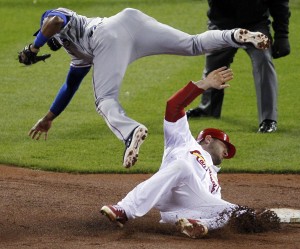Breaking up a double play
August 16, 2012 by Coach McCreary
Filed under Base Running
One of the many jobs of a first base coach is to tell every runner at first base to “break up a double play” if there are less than two outs. How it is done depends on what level the player finds himself on but the main idea is that going hard to second base and
sliding hard as well should not be optional. Unfortunately, along with bunting, it seems to be a forgotten part of the game for many players.
I found myself shaking my head again last night as a major league player coasted into second base and then peeled off to get out of the way of the throw to first by the shortstop on a double play. Didn’t run hard and didn’t slide. In a one run game (his team was losing) in the 8th inning. Inning over and his team went on to lose.
I shake my head because that’s not how you play the game. You play it hard all the time. No exceptions.
When it comes to breaking up a double play, there is a big difference between sliding hard according to the rules and playing dirty. Below are some do’s and don’ts when it comes to breaking up a double play. Be sure to read both regardless of what your rules are. Several of the tips apply to all runners at all levels.
If the rules say you must slide directly into the bag (usually high school and below):
- Anticipate having to break up two every time you get on first base. Take an aggressive secondary lead on the pitch and if the ball is hit on the ground, put your head down and run as hard as you can in a straight line to second base.When sliding, slide as you would on a straight steal. Feet first and into the bag. Keep your lead leg down like you normally would. Dirty slides occur when the runner lifts his lead spike shin-high or higher to get the fielder with it. Not good.
- Do not slide past the bag in order to make contact with the fielder who might be behind it.
- Slide with your hands off the ground. Not waving in the air to distract the fielder or to touch the ball but to avoid your hands and fingers from being stepped on by the fielder.
- Pop-up slides are ok if it is done in a normal fashion and not just to ram into a fielder.
- Don’t assume you are out. Stay on second base until the umpire tells you that you are out.
If the rules say you are able to be within an arms length of the bag when sliding:
- Watch infield practice!! Do so in order to see where the middle infielders go on double plays. The shortstop will just about always go across the bag. It can vary for the second basemen. Some like to come across. Some step back off the bag. Some stay behind the bag and use the bag for protection. Do some scouting to see who the starting second baseman will be and where he likes to go on double plays. If he takes all his double play feeds in practice by going across the bag, you know where he is going to be in the game. If you are on first and a grounder is hit, put your head down and run to the spot where you know he will be. Note: If you are a second baseman, it’s important to use a variety of double play turns in pre-game practice to not allow the runners the chance to know beforehand where you are going to be.
- Wherever the fielder goes, slide on that side of the bag within arms reach and as before, keep your lead foot/spikes down. Let the contact with the fielder occur naturally on the slide. Do not kick, grab, or reach for an infielder on the slide.
Other notes:
- Peeling off means veering left or right out of the baseline without a slide to avoid getting hit by the ball. The only time this would be somewhat ok is when the play happens so fast that the runner isn’t more than half way to second base when the ball is being thrown to first. Personally, I’d still like to see my runner slide even if they will never reach the bag. Veering off is just giving up. Any slide and/or runner in the path of the throw can spook a fielder enough to alter his throw.
- Do not go into second base standing up. I’ve seen a couple runners do this in order to disrupt the fielder and his throw. A runner tried to do this to me and almost got a ball between his eyes in the process. Play hard but don’t be stupid either.






Leave a Reply